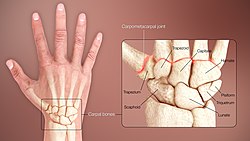This article may be too technical for most readers to understand. (June 2015) |
| Wrist | |
|---|---|
 A human showing the wrist in the centre | |
 The carpal bones, sometimes included in the definition of the wrist | |
| Details | |
| Identifiers | |
| Latin | articulatio radiocarpalis |
| MeSH | D014953 |
| TA98 | A01.1.00.026 |
| TA2 | 147 |
| FMA | 24922 |
| Anatomical terminology | |
In human anatomy, the wrist is variously defined as (1) the carpus or carpal bones, the complex of eight bones forming the proximal skeletal segment of the hand;[1][2] (2) the wrist joint or radiocarpal joint, the joint between the radius and the carpus[2] and; (3) the anatomical region surrounding the carpus including the distal parts of the bones of the forearm and the proximal parts of the metacarpus or five metacarpal bones and the series of joints between these bones, thus referred to as wrist joints.[3][4] This region also includes the carpal tunnel, the anatomical snuff box, bracelet lines, the flexor retinaculum, and the extensor retinaculum.
As a consequence of these various definitions, fractures to the carpal bones are referred to as carpal fractures, while fractures such as distal radius fracture are often considered fractures to the wrist.
- ^ Behnke 2006, p. 76 "The wrist contains eight bones, roughly aligned in two rows, known as the carpal bones."
- ^ a b Moore KL, Agur AM (2006). Essential clinical anatomy. Lippincott Williams & Wilkins. p. 485. ISBN 0-7817-6274-X.
The wrist (carpus), the proximal segment of the hand, is a complex of eight carpal bones. The carpus articulates proximally with the forearm at the wrist joint and distally with the five metacarpals. The joints formed by the carpus include the wrist (the radiocarpal joint), intercarpal, carpometacarpal, and intermetacarpal joints. Augmenting movement at the wrist joint, the rows of carpals glide on each other [...]
- ^ Behnke 2006, p. 77 "With the large number of bones composing the wrist (ulna, radius, eight carpas, and five metacarpals), it makes sense that there are many, many joints that make up the structure known as the wrist."
- ^ Baratz M, Watson AD, Imbriglia JE (1999). Orthopaedic surgery: the essentials. Thieme. p. 391. ISBN 0-86577-779-9.
The wrist joint is composed of not only the radiocarpal and distal radioulnar joints but also the intercarpal articulations.